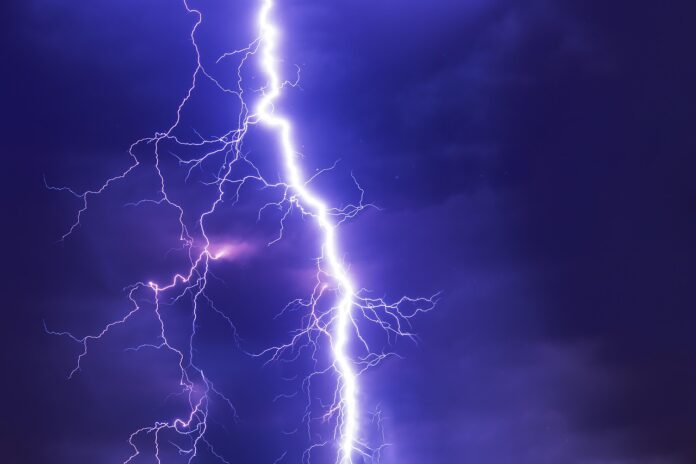- A single lightning bolt stretched 515 miles from Texas to Kansas City, setting a new world record for the longest flash ever recorded.
- Scientists used advanced satellite technology to detect the megaflash, highlighting the growing reach and danger of extreme lightning events.
- Experts warn that lightning can strike far from storms and urge the public to seek proper shelter during thunderstorms, even if the sky appears clear.
It was a flash like no other—bright, bold, and shockingly long. A single bolt of lightning, unleashed during a massive thunderstorm in October 2017, has officially rewritten the record books. Stretching an astonishing 515 miles, this unprecedented electrical discharge soared from eastern Texas all the way to the outskirts of Kansas City, Missouri. That’s about 38 miles farther than the previous record, set just three years later in 2020.
To put it simply: this lightning bolt could have spanned the entire length of England, or bridged the gap between Paris and Venice. If you were driving its full length, you’d need nine hours and a full tank of gas. Flying? At least 90 minutes in the air.
But this wasn’t just a jaw-dropping show of nature’s power—it was a wake-up call.
The Sky Isn’t the Limit: This Bolt Broke All Expectations
The lightning, now dubbed a “megaflash,” is more than just a record holder. It represents the incredible scale of today’s thunderstorms and how far science has come in tracking their impact. The World Meteorological Organization (WMO) confirmed the lightning bolt’s massive reach using cutting-edge satellite technology.
“This wasn’t just a scientific curiosity—it’s a public safety concern,” warned Celeste Saulo, the WMO’s Secretary-General. She pointed out that lightning is one of the deadliest weather-related phenomena worldwide. With megaflashes like this, danger doesn’t just come from above—it could be arriving from hundreds of miles away.
The concern goes beyond people on the ground. Long-range lightning poses serious risks for the aviation industry, as well as the growing threat of wildfires. The massive storms that birth these superbolts can ignite forests, knock out power grids, and endanger lives from regions that aren’t even under the storm clouds.
Satellites See What We Can’t
For decades, lightning detection was limited to ground-based stations. While those systems work well for nearby strikes, they struggle to capture lightning’s true reach. That changed in 2017, when new satellite-borne sensors began orbiting above Earth. These high-tech eyes in the sky can monitor lightning across entire continents—tracking every flicker, fork, and flash.
“Before, we were only catching glimpses,” said Michael J. Peterson, the lead author of the study from Georgia Tech. “Now, with continuous satellite coverage and better data analysis, we can finally capture lightning at its full scale.”
And that’s critical, he adds, because these monster flashes are rare—and hard to study. As our global lightning data grows year by year, scientists believe even longer flashes may be out there, waiting to be discovered.
A Dangerous Show in the Sky
Lightning is both beautiful and brutal. The majority of flashes are short-lived—typically under 10 miles. But when storms grow large enough and last long enough, they can birth megaflashes: bolts that travel more than 60 miles in a single strike.
The 2017 megaflash occurred in a storm system that likely brewed for more than 14 hours and stretched across a wide swath of the southern U.S. The sheer size and duration created the perfect conditions for a flash of epic proportions.
And this isn’t the only time lightning has shocked the world with its scale. In June 2020, another bolt earned the record for longest duration—lasting 17.1 seconds—over parts of Uruguay and Argentina. Meanwhile, in 1975, a single direct lightning strike tragically killed 21 people in Zimbabwe, and in 1994, a bolt indirectly caused the deaths of 469 people in Egypt after igniting oil tanks that flooded the town of Dronka with flames.
These chilling records serve as stark reminders that lightning doesn’t just strike—it devastates.
The Public Reacts: “That Could’ve Hit Anywhere”
News of the 515-mile bolt has sparked both awe and anxiety. Social media lit up with reactions ranging from fascination to fear. One user posted, “A lightning bolt longer than my whole state? That’s insane.” Another wrote, “So you’re telling me a storm in Texas could send lightning to Kansas City? I’m never leaving my house in the rain again.”
And they’re not entirely wrong to worry. The WMO and experts like Walt Lyons, a veteran lightning specialist, emphasize the importance of taking lightning seriously—no matter how far away the storm seems.
“People think if the sky’s clear above them, they’re safe. But that’s just not true,” Lyons explained. “Lightning can strike dozens—or hundreds—of miles from its source.”
The key takeaway? Distance doesn’t guarantee safety. That flash you see far off on the horizon might not be staying there.




